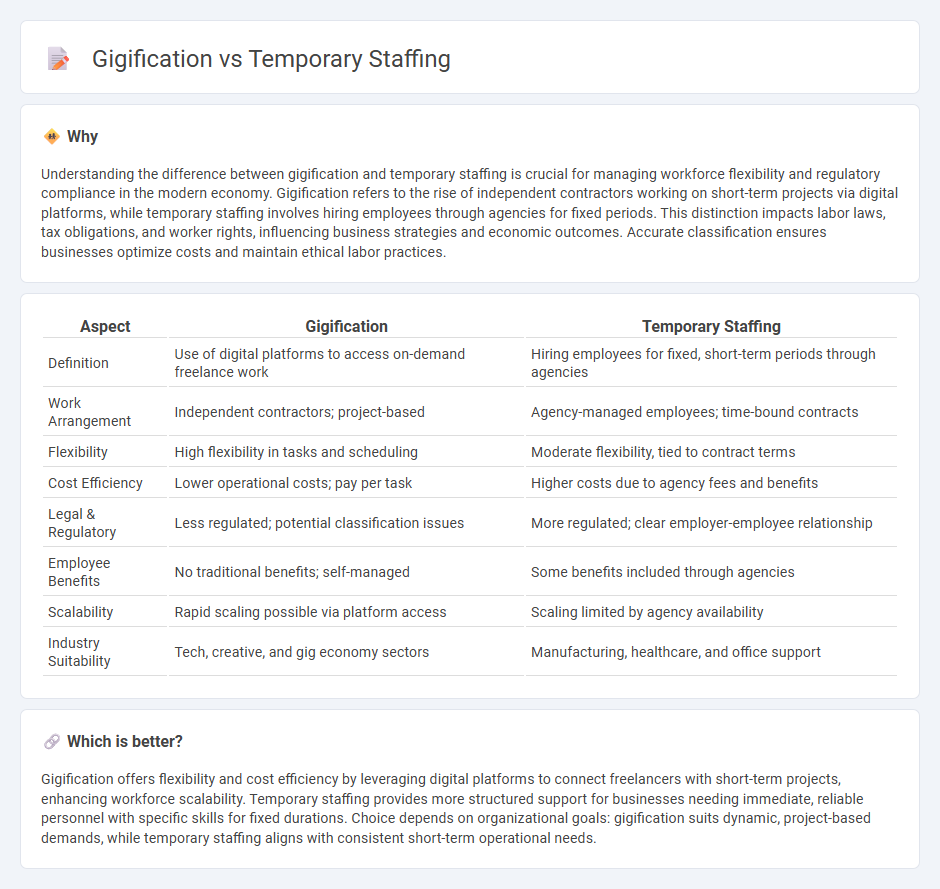
Gigification transforms traditional work by leveraging digital platforms to connect freelancers with short-term projects, enhancing flexibility and access to diverse opportunities. Temporary staffing involves hiring workers for fixed periods through agencies, ensuring businesses meet immediate labor demands with vetted personnel. Explore how these workforce models reshape economic dynamics and employment trends.
Why it is important
Understanding the difference between gigification and temporary staffing is crucial for managing workforce flexibility and regulatory compliance in the modern economy. Gigification refers to the rise of independent contractors working on short-term projects via digital platforms, while temporary staffing involves hiring employees through agencies for fixed periods. This distinction impacts labor laws, tax obligations, and worker rights, influencing business strategies and economic outcomes. Accurate classification ensures businesses optimize costs and maintain ethical labor practices.
Comparison Table
| Aspect | Gigification | Temporary Staffing |
|---|---|---|
| Definition | Use of digital platforms to access on-demand freelance work | Hiring employees for fixed, short-term periods through agencies |
| Work Arrangement | Independent contractors; project-based | Agency-managed employees; time-bound contracts |
| Flexibility | High flexibility in tasks and scheduling | Moderate flexibility, tied to contract terms |
| Cost Efficiency | Lower operational costs; pay per task | Higher costs due to agency fees and benefits |
| Legal & Regulatory | Less regulated; potential classification issues | More regulated; clear employer-employee relationship |
| Employee Benefits | No traditional benefits; self-managed | Some benefits included through agencies |
| Scalability | Rapid scaling possible via platform access | Scaling limited by agency availability |
| Industry Suitability | Tech, creative, and gig economy sectors | Manufacturing, healthcare, and office support |
Which is better?
Gigification offers flexibility and cost efficiency by leveraging digital platforms to connect freelancers with short-term projects, enhancing workforce scalability. Temporary staffing provides more structured support for businesses needing immediate, reliable personnel with specific skills for fixed durations. Choice depends on organizational goals: gigification suits dynamic, project-based demands, while temporary staffing aligns with consistent short-term operational needs.
Connection
Gigification and temporary staffing both contribute to labor market flexibility by enabling businesses to adjust workforce size based on demand fluctuations. Gigification often relies on digital platforms that facilitate short-term, task-based contracts, while temporary staffing agencies provide vetted professionals for fixed-term assignments. Together, these models reduce long-term employment commitments and offer cost-effective solutions for managing operational needs.
Key Terms
Employment Contracts
Temporary staffing relies on fixed-term employment contracts that outline specific job duration, duties, and benefits, ensuring legal protections and structured payroll management. Gigification, by contrast, often utilizes independent contractor agreements, providing flexibility but less regulatory oversight and fewer employee benefits. Explore how these contract types impact workforce stability and compliance by learning more.
Flexibility
Temporary staffing offers organizations a flexible workforce to meet short-term needs, with employees often working under formal contracts and receiving benefits. Gigification emphasizes on-demand, project-based work performed by independent contractors, maximizing flexibility for both workers and companies through digital platforms. Explore the differences and benefits of these workforce models to optimize your business strategy.
Labor Intermediation
Temporary staffing involves agencies acting as labor intermediaries by connecting employers with workers for fixed-term assignments, ensuring compliance with labor laws and managing payroll and benefits. Gigification refers to the rise of digital platforms that facilitate direct matching between clients and independent contractors, often bypassing traditional intermediaries and shifting liability and benefits away from platform operators. Explore the evolving landscape of labor intermediation to understand how these models impact workforce flexibility and legal frameworks.
Source and External Links
Temporary Staffing Services - Staff Human Resources - Temporary staffing services are used to fill short-term assignments of less than six months in administrative, professional, technical, and light industrial roles, with background checks required for critical positions.
Elite Staffing: Temporary Employment Services & Staffing Agency - Elite Staffing provides contract and temporary employment services, including direct hire and on-site managed staffing programs with a national reach, serving businesses and job seekers across the U.S.
LaborMax Staffing: Home - LaborMax Staffing offers pre-screened temporary staff to quickly meet short-term needs, handling payroll, background checks, compliance, and performance monitoring, with flexible scaling and 24/7 support.
 dowidth.com
dowidth.com